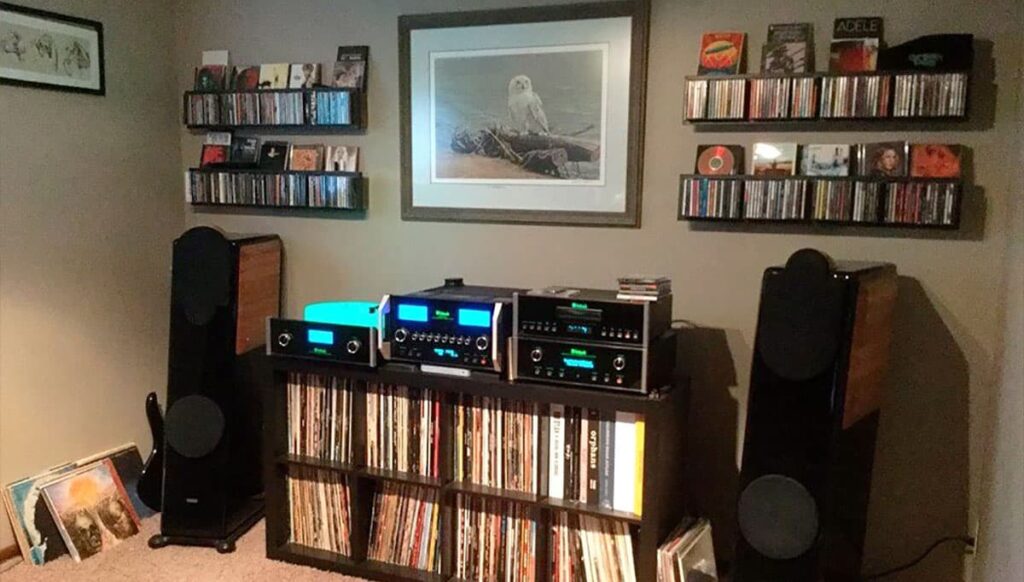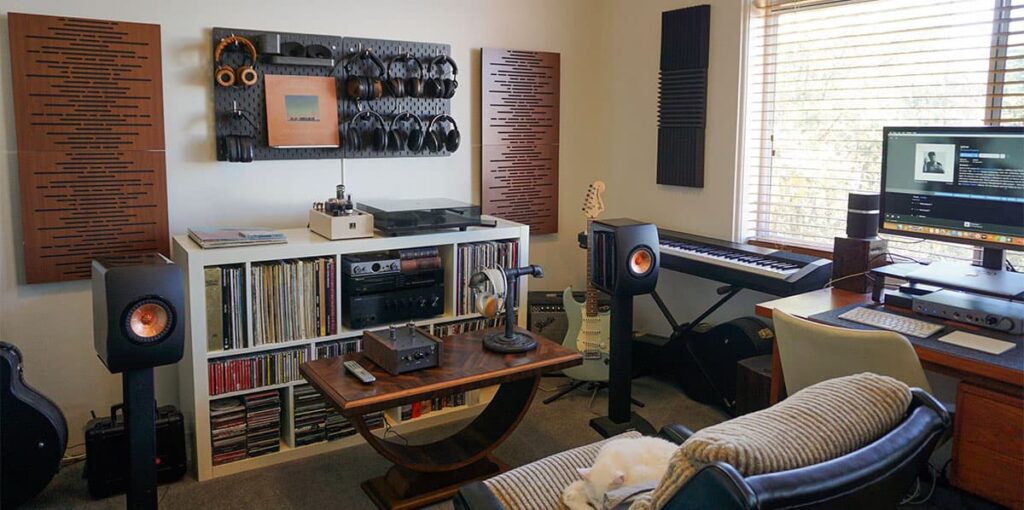When it comes to my music listening room, I envision a cozy space with great acoustics that allows me to get lost in the songs I truly love. Creating the ideal space is important if you really want to enjoy your music collection.
In this article, I’ll walk you through everything you need – from sound treatment and speaker placement to lighting and seating – to audiophile room design that facilitates a great listening experience. We’ll cover everything from basic principles of optimizing audio quality to more subtle environmental factors that can take your enjoyment of music to the next level.
Importance of a listening room
See, most living rooms or bedrooms aren’t optimized for critical listening. Hard surfaces and flat walls create messy audio reflections that muddy up the sound. It’s like trying to see your reflection in rippled water – not exactly clear. But a thoughtfully crafted listening room keeps those sound waves in check so you hear all the crisp detail and spatial imaging that went into your favorite recordings.
Beyond controlling reflections, attention to lighting, seating, and layout removes visual and physical distractions so you can devote your senses entirely to the musical experience. You might be surprised how these environmental factors make a difference in how deeply you can engage with and emotionally connect to the music. That heavy bass hit somehow hits even harder when your surroundings are dialed in. It’s your own space to spread out, crank up the volume, and enjoy album after album free from interruptions. I don’t know about you, but that sounds blissful!

Choosing the right space
Ideally, you want a rectangular room with a solid door, no windows, and 12 to 25 square meters of empty floor space to work with. This allows enough real estate for proper speaker positioning and freedom to experiment with acoustic treatments. A basement or ground floor room is perfect since you don’t have to worry about noisy neighbors below or restrictions on constructing acoustic panels or bass traps.
Don’t just shove your hi-fi into the corner of an everyday living room! Remember, this space has a singular purpose: enjoying music. Streamline the layout with wide pathways and minimal furniture not related to listening. Make sure the sight lines between speakers and seating are clear, too. Even visual clutter is a distraction. It’s all about creating a peaceful, uncluttered refuge to get lost in your favorite recordings for hours undisturbed.
Acoustic treatment
If top-notch sound quality matters, room acoustic design treatment should be high on your listening room priority list. Hard, flat walls create messy audio reflections that distort the imaging, detail, and tone artists and producers meticulously crafted into recordings.
Treating the room isn’t just for persnickety audiophiles. Do it right, and everything will sound more open, precise, and realistic – like you’re at the recording session or live concert. Vocals come through with lifelike textures. You hear subtle instrumental flourishes as if for the first time.
You don’t have to go overboard. Start by adding broadband absorption at the first reflection points on the walls and ceiling to clean up the soundstage. Bass traps in corners tame boomy low-end by stopping those pesky low-frequency standing waves. Diffusers scatter sound uniformly to enhance immersion and widen the sweet spot.

Audio equipment essentials
Outfitting any space doesn’t have to break the bank, even when adding soundproofing for a music room. Audio gear can get crazy expensive, but for most of us, a modest two-channel system gets the job done. The key is spending wisely for your budget.
As a rule of thumb, invest more in speakers and amplification over sources. Amazing speakers can make moderate electronics sing, but beefy components can’t offset so-so speakers. For speakers, prioritize tonal neutrality over blow-your-hair-back power so the true tone of albums shines through. Tower speakers around $1000/pair, like the Dali Oberon 5 or KEF R3, give you a huge bang for the buck. Add $400 bookshelves as surrounds if you have a larger room and want to add multichannel music listening or home theater down the line.
Most $500 stereo receivers and integrated amps supply plenty of clean power to drive speakers in this class. Consider $300-$400 amps like the Rotel A12 if on a tighter budget. Get the greatest turntable your remaining dollars allow. Something like a $400 Fluance RT85 or $600 Rega Planar 1 will do LPs justice while leaving cash for key room treatments. Don’t forget – room acoustics and speaker positioning matter just as much.
Take time auditioning components together at your local hi-fi shop to maximize synergy too. It’s not just about choosing individual pieces – achieving a cohesive system matters hugely for musical satisfaction. Think through your priorities, invest where it counts most, and enjoy the tunes!